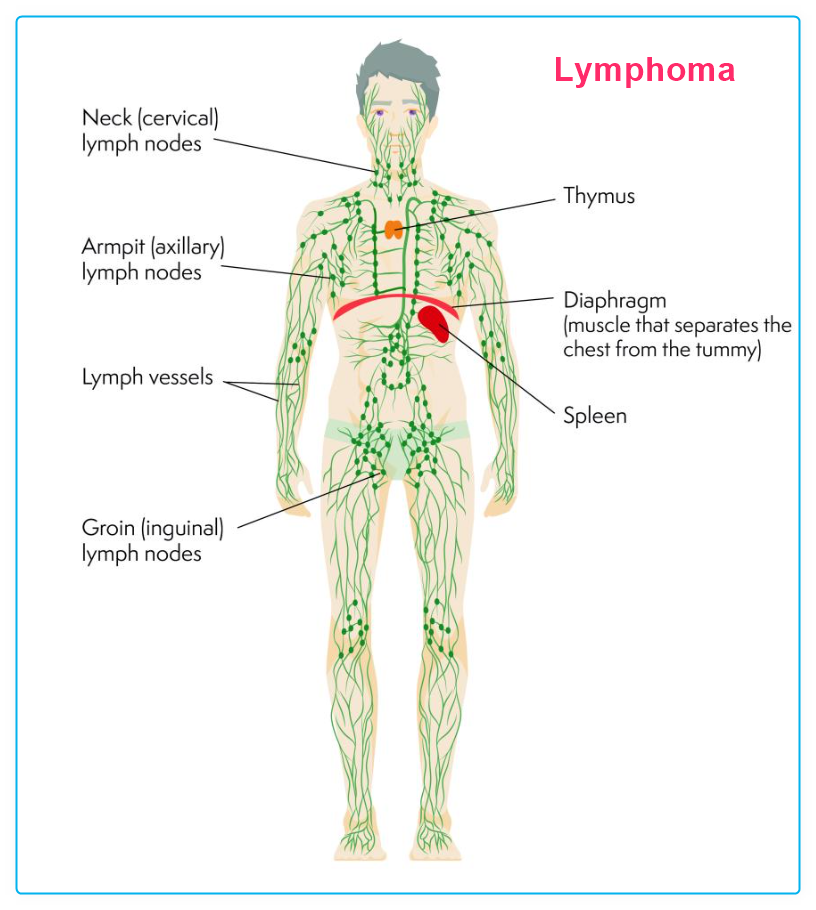Cancer - Lymphoma

Click here to see source of chart
Lymphoma items
see also
Lymphoma treated by Vitamin D - many studies
Web articles are below the follwing list
Lymphoma articles
{category}
AI able to detect 90% of Lymphoma sites - March 2024
Does not appear to mention % caught by humans
2X more likely to die of lymphoma if low vitamin D - meta-analysis March 2021
Meta-analysis of the prognostic and clinical value of serum 25-hydroxyvitamin D levels in previously untreated lymphoma
Future Oncol. 2021 Mar 17. doi: 10.2217/fon-2020-0914
Yunxia Tao 1, Haizhu Chen 1, Yu Zhou 1, Yuankai Shi 1
Background: This meta-analysis explored the prognostic and clinical value of serum 25-hydroxyvitamin D, 25(OH)D, levels in previously untreated lymphoma.
Materials & methods: PubMed, Web of Science, Embase and the Cochrane Central Register of Controlled Trials databases were searched for eligible studies. Summary effect estimates and 95% CIs were pooled using random-effects or fixed-effects models.
Results: Twelve studies with 4139 patients were included. Low level of serum 25(OH)D was associated with inferior progression-free survival (hazard ratio [HR]: 2.06; 95% CI: 1.82-2.32) and overall survival (HR: 1.94; 95% CI: 1.71-2.19), advanced disease (odds ratio [OR]: 1.52; 95% CI: 1.09-2.13) and elevated lactate dehydrogenase (OR: 1.84; 95% CI: 1.08-3.15).
Conclusions: Low level of serum 25(OH)D is a prognostic risk factor for newly diagnosed lymphoma.
PDF costs $67
25(OH) vitamin D deficiency in lymphoid malignancies, its prevalence and significance. Are we fully aware of it? - Aug 2018
Support Care Cancer. 2018 Aug;26(8):2825-2832. doi: 10.1007/s00520-018-4101-9. Epub 2018 Mar 6.
25(OH) vitamin D deficiency in lymphoid malignancies, its prevalence and significance. Are we fully aware of it?
Djurasinović VT1,2, Mihaljević BS3,4, Šipetić Grujičić SB5, Ignjatović SD6, Trajković G7, Todorović-Balint MR3,4, Antić DA3,4, Bila JS3,4, Andjelić BM3,4, Jeličić JJ3, Vuković VM3, Nikolic AM5, Klek S8.
INTRODUCTION:
Vitamin D has a role in cellular differentiation, proliferation, apoptosis, and angiogenesis and therefore is studied as a prognostic factor in cancer. The aim of our study was to assess the prevalence and significance of 25(OH)D deficiency in patients with lymphoid malignancies.
METHODOLOGY:
Between January 2014 and June 2016 at the Clinic for Hematology, Clinical Center of Serbia, Belgrade, the pretreatment serum level of 25(OH)D was determined in 133 (62 women/71 men, median age 58 (18-84) years) previously untreated patients with lymphoid malignancy using a chemiluminescent immunoassay. From their medical records, we noted the age, clinical stage, Eastern Cooperative Oncology Group Performance Scale (ECOG PS), nutritional status using the Nutritional Risk Score 2002 (NRS2002), the time of year, comorbidity index, progression, and progression-free survival (PFS) for a median of 20 (1-32) months. The optimal cutoff point for prediction of outcome was determined using the Maximally Selected Rank Statistics.
RESULTS: There were
37 (27.8%) patients with the severe 25(OH)D deficiency ≤ 25 nmol/l,
80 (60.2%) with 25(OH)D deficiency 25-50 nmol/l, and
16 (12%) with 25(OH)D insufficiency 50-75 nmol/l.
None of the patients had the desired normal level . There were significant differences between groups in regard to ECOG PS, NRS2002, type of lymphoma, and progression. The severely 25(OH)D-deficient patients had a shorter mean time until progression (P = 0.018). Cox regression analysis showed that 25(OH)D < 19.6 nmol/l remained the only significant parameter for PFS (HR = 2.921; 95% CI 1.307-6.529).
CONCLUSION:
The prevalence of 25(OH)D deficiency in the analyzed group of patients with lymphoid malignancies is high and greater in malnourished individuals. Patients with pretreatment serum 25(OH)D < 19.6 nmol/l had a significantly shorter PFS.
Hodgkin Lymphoma is inversly related to altitude (more UVB, less HL) - Nov 2019
Ecological Evidence for Lower Risk of Lymphoma with Greater Exposure to Sunlight and Higher Altitude
High Alt Med Biol. 2019 Nov 25. doi: 10.1089/ham.2019.0054
Merrill RM1, Frutos AM1.
Merrill, Ray M., and Aaron M. Frutos. Ecological evidence for lower risk of lymphoma with greater exposure to sunlight and higher altitude. High Alt Med Biol. 20:000-000, 2019. Introduction: Sunlight exposure increases vitamin D-related immune modulation and motility of T lymphocytes. Blue light exposure from the sun can stimulate immune function and help promote healthy circadian rhythm. Hence, greater sunlight exposure may lower the risk of Hodgkin lymphoma and non-Hodgkin lymphoma (NHL). Altitude may also lower the risk of these cancers through an oxygen-related mechanism, and because cosmic radiation has less shield from the atmosphere at higher levels, it allows for radiation hormesis. Methods: An ecological study design was used, with county-level lymphoma, sunlight, altitude, urban residency, poverty, smoking, obesity, and leisure-time physical inactivity data for 16 cancer registries (607 counties) in the contiguous United States, 2012-2016. Relative rate estimates were derived from two-level mixed effects Poisson regression models. Results: Higher rates of NHL are associated with being older, male, and white. Higher rates of Hodgkin lymphoma are associated with ages 20 years and older, male, and white or black. The risk of NHL or Hodgkin lymphoma is lower among those living in poverty. Urban residency, smoking, obesity, and physical inactivity are not associated with these cancers. Both increased sunlight exposure and higher altitude are simultaneously associated with lower rates of Hodgkin lymphoma and NHL in adjusted models. The inverse association between sunlight and NHL is more pronounced with higher altitude. The inverse association between sunlight and Hodgkin lymphoma is only in altitudes below 500 m. Conclusions: Greater sunlight exposure and higher altitude are simultaneously associated with lower rates of Hodgkin lymphoma and NHL. The inverse associations are dependent on altitude, with the relationship only in lower altitudes for Hodgkin lymphoma and more pronounced in higher altitude for NHL.
